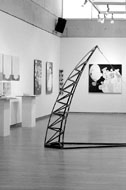|

Comment
on this story
What:
Honors Exhibition
Where:
UT's Ewing Gallery of Art and Architecture, 1715 Volunteer Boulevard (call 974-3200 for information)
When:
through June 6
|
|

Graduating students get a chance to show off
by Heather Joyner
As should be the case, numerous shows mounted by UT's Ewing Gallery highlight student efforts. And within that category, the annual Honors Exhibition possesses a certain cachet. Comprised of undergraduate art and architecture projects, honors shows acknowledge individuals selected by either faculty members or outside jurors.
Gallery Director Sam Yates explains that after graduating art students are nominated, a committee looks at slides or video material and visits studio spaces to narrow down the choices. Then, says Yates, "They huddle and debate." He continues, "Because the exhibition is shared with 5th-year architecture students, the committee knows that if too many people are involved, they can't show as much work."
In addition to seven architecture projects, this year's event includes sculpture, painting, media arts, and printmaking pieces by eight B.F.A. candidates. Says Yates, "Once we pick the students, we tell them they've been chosen and let them do what they want...it's an opportunity for them to do something they've always wanted to do."
Sometimes, student works that are on view signal a departure from an established direction.
For instance, photographer Julia Hungerford presents a video installation entitled "The Four Questions." Alluding to the Passover seder, it features a table and chairs, two television sets, and cloth napkins that phonetically spell out Hebrew script. In an accompanying statement, Hungerford asserts that "...the idea of compromising sacred text for the convenience of English-speakers reflects an abandonment of tradition and reflects the changing Jewish population, which is also evident within my own family."
Even more conveniently "digested" are the simultaneously playing videos. In one, the camera pans male and female diners as they feed each other with exaggerated gestures. The second, more lascivious tape shows (among other things) "Easy Cheese" writing being applied to a woman's naked back. To put it mildly, there's a lot going on.
Adjacent to Hungerford's table is Rob Travis' "Closed Circuit," another installation with television as its focus. But here, a pair of mod vinyl chairs face a static image of themselves on screen. Travis states, "I have only provided the medium for which to deliver your message to yourself"—whatever that means.
Mass media consumerism as all encompassing is suggested by a large convex mirror on the wall. Needless to say, it's a visual relief to enter another section of the gallery and see more traditional fare.
Paintings by Bettina McCann have luxuriant surfaces and textural intricacies that complete—rather than compete with—each image as a whole. Her "The hyPATHalamus Event" consists of clay board sections placed in a corner as if they might fold together. Markings resembling Rorschach inkblots could somehow be messages, if not painted poppies from a deconstructed silk kimono. And McCann's piece titled "Single Cell Anecdote" is, quite simply, marvelous.
Color and pattern are the basis for five prints by Brooke Horne and paintings by Courtney Hager, as well, but they lack the oomph of McCann's work. Also lacking punch is Thomas Sturgill's "220 Useful Parts," a mixed-media construction including gutted halves of an old cassette-tape recorder next to screws, washers, springs, batteries, and other items separated into baggies pinned to the wall. As such, the piece reflects a meaningless taxonomic exercise; obsessive-compulsive categorization with no particular objective. Sturgill's "Lifecycle/ Chance Study #1," with its continuously printed-out calculations, is equally absurd but far more fun.
As for sculpture, Jeff Crawford's "Asphyxiation Device" dominates the gallery entrance with four pyramidal steel structures suspending a platform from guide wires. When turned on, a mask with a hose attached to a curved white shape on the platform appears to inhale and vibrate. The central shape could better connect with surrounding forms, but "Asphyxiation Device" is nothing if not ambitious. Crawford's scattered steel pieces on roller-skate wheels add a jaunty note to the exhibition.
Ben Eng's work is quieter, but not without intensity. For example, five human-size heads made from clustered match sticks (titled "Process of Inevitability") occupy pedestals, their very materials lending them a pronounced urgency. Burned matches forming one "face" make it decidedly eerie.
Displayed architecture projects are impressive. Ryan Cole's "Aurora Borealis: Observation and Interpretive Center," a roundish structure (echoing celestial infinity?) intended for a site in Alaska, is the big award winner. But Anthony Dottore provides the most extensive proposal, complete with a grid matrix display, wood blocks for printing, light studies for different spaces, and color images of buildings adjacent to his site as well as the usual floor plans and elevations. The center for "M. C. Escher exploration" is a fascinating idea, albeit overwhelmed by Dottore's dizzying presentation.
Charlie Rankin describes his spare urban living designs, saying, "Clients would be able to own a modular housing system with improved flexibility, natural lighting, and outdoor space over traditional modular housing."— To which I say "hallelujah." Chung Yang's Atlanta-based "Pure Gap" is Euro-dry and high-tech/super-hygienic, but it seems to fit The Gap's desired image.
Personally, I find projects designed for local sites quite interesting, if only because their context is familiar. Of three proposals fitting that description—by Wendy Cooper, Nathan Honeycutt, and Erica Walczak—it is the latter student's "Habitat Exploration and Research Center" on Neyland Drive that I'd most like to see become reality. Like Walczak, I lament what she's termed as UT and downtown Knoxville "turning their backs on the river," and her "framework for developing the river edge as a 'pedestrian friendly' environment" is clever as well as community-minded.
If we're lucky, maybe these artists will stay in Knoxville. Whatever the case, we can enjoy their work for the next three weeks.

May 15, 2003 * Vol. 13, No. 20
© 2003 Metro Pulse
|